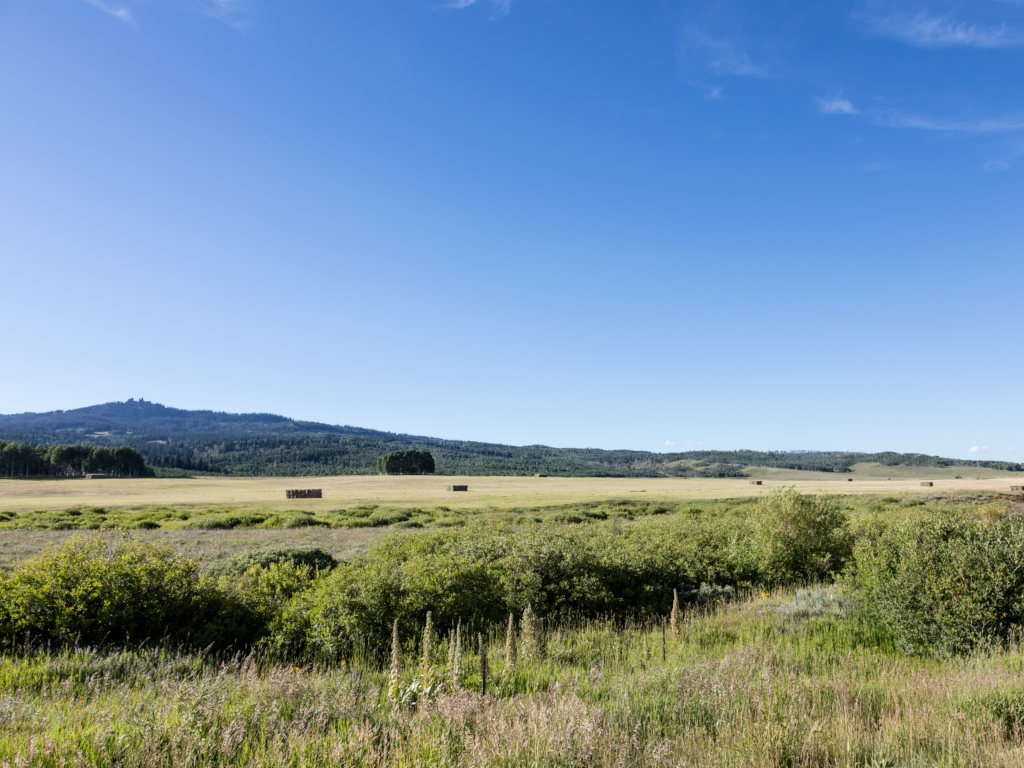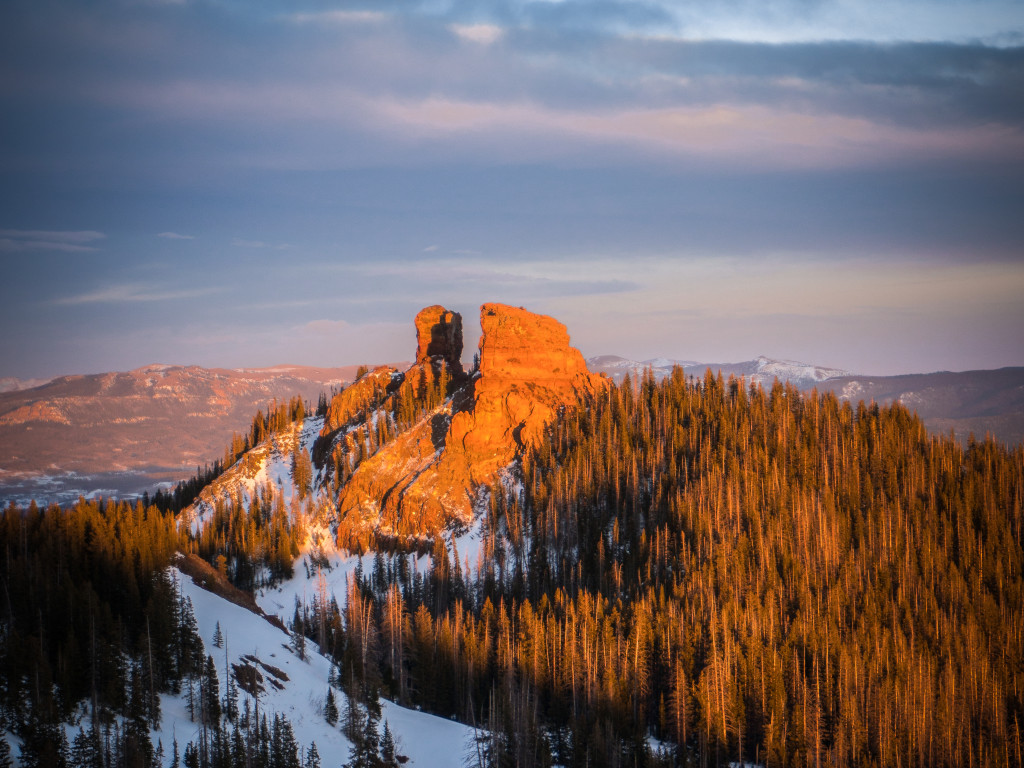Rabbit Ears Pass
Rabbit Ears Pass is a scenic mountain pass located in northern Colorado, connecting the towns of Steamboat Springs and Kremmling. The pass is located on US Highway 40 and is a gateway to the Routt National Forest. The pass gets its name from two rock formations located on the pass that resemble the ears of a rabbit. These can easily be seen from the road.
Muddy Pass is located on the eastern side of Rabbit Ears Pass, and this is where the road begins its ascent into the Rabbit Ears Range. Both of these passes cross over the Continental Divide.

Seasonal Info
Rabbit Ears Pass is open year-round. You can expect the pass to close temporarily during the winter for severe snowstorms.
Rabbit Ears Pass Stats
- Max Road Elevation: 9,426'
- Rabbit Ears Elevation: 10,675'
- Length: 17.8 Miles

Alternate Routes – If Rabbit Ears Pass is closed you may be able to use Gore Pass (HWY. 134). This highway is located to the south and can get you from Kremling to Steamboat Springs.

Recreation on Rabbit Ears Pass
Rabbit Ears Pass is a popular destination for outdoor activities year-round. Much of the pass has a mild pitch, gentle slopes, or no slope at all. This makes it an ideal place for snowmobiling and cross-country skiing. The backcountry here has been visited by skiers for more than a century.
Here are some examples of popular activities:
Summer
- Camping
- Cycling & Mountain Biking
- Fishing
- Hiking
- Horseback Riding
Winter
- Skiing & Snowboarding
- Cross-Country Skiing
- Snowmobiling
- Snowshoeing
Summer
- Camping
- Cycling & Mountain Biking
- Fishing
- Hiking
- Horseback Riding
Winter
- Cross-Country Skiing
- Skiing & Snowboarding
- Snowshoeing
- Snowmobiling
Rabbit Ears Pass FAQ
We have measured it at 17.8 Miles. This measurement starts at the summit of Muddy Creek Pass where Rt. 14 and Rt. 40 intersect. This measured distance ends on the western side of the pass where you exit the main portion of the Rabbit Ears Range (at the intersection of Rt. 40 and Rt. 20).
Rabbit Ears Pass is located to the southeast of Steamboat Springs, crossing the Rabbit Ears Range.
There are no services or amenities such as gas stations, but there are plenty of parking areas along the highway.
Compared to other mountain passes like Loveland Pass it is relatively safe. However, it is still a winding mountain road that can get lots of snow, so it can be hazardous at times.
There are no tolls or fees for this mountain pass.
Yes, but it can be closed temporarily in the winter months during the worst snowstorms.
You can do this in just under 20 minutes if the weather is good.
Backcountry Skiing and Snowboarding: There is a variety of terrain ranging from wide open bowls, steep chutes, and easier forested trails. Cross-country skiing is popular here because most of the pass does not have enough pitch for downhill skiing.
Camping: Free dispersed camping can be found on the pass as well as Dumont Lake Campground.
Fishing: Some of the common fish species found are rainbow trout, brook trout, and cutthroat trout. Try fishing at Dumont Lake on the northern side of the pass.
Hiking: Rabbit Ears Pass offers a variety of trails ranging from easy to strenuous. Some popular hiking trails include Rabbit Ears Peak Trail, Dumont Lake Trail, and Gorge Range Trail.
Mountain Biking: A popular route is the Continental Divide Trail.
Snowmobiling: Known as the state’s snowmobiling mecca, snowmobilers can enjoy guided tours or freeriding.

Directions from Denver
How to get to Rabbit Ears Pass from Denver?
- I-70 Westbound
- Take exit 205 at Silverthorne/Dillon
- Turn right onto Rt. 9 into Kremling
- Turn left onto Rt. 40 and head up Rabbit Ears Pass
Did You Know?
The Rabbit Ears are the result of an ancient volcanic explosion. The rock formation at the peak is made from volcanic rock. No climbing is allowed because parts of the rabbit ears formation are quickly eroding.

The photo above with the Rabbit Ears barely visible in the upper left shows the flatness of the terrain on Rabbit Ears Pass. Below you can see the Rabbit Ears up close at sunset.

Rabbit Ears Pass History
Before the modern highway over Rabbit Ears Pass was built, there was a trail here that was used by people, horses and mules. It became well-traveled towards the end of the 19th century, and wagon road did exist here before the modern roadway was built.1, 2
Work on the modern dirt roadway began in 1911. The road was completed sometime between late July and August of 1915.3, 4, 5
A marker at the top of Rabbit Ears Pass on the old route (now Grand County Road 199) reads: “Improved Highway Opened 1919”. It was not uncommon for mountain highways that were built during the early 1900s in Colorado to be re-graded and re-aligned every few years.
The first time that crews attempted to keep the highway on Rabbit Ears Pass open throughout the winter was in 1932, but they were unsuccessful. An article from the Steamboat Pilot in April of 1933 reads:
“There Is no probability of Rabbit Ears pass being opened soon because of the snow depth of over 9 feet on the level and drifts in spots as high as 20 feet.” 5
It wouldn’t be until the winter of 1936-37 that the pass would remain open through the winter for the first time. A rotary snowplow was brought over from Berthoud Pass to assist in January, and a similar plow would arrive here to take its place and remain permanently in March.7, 8





Rabbit Ears Pass Events:
The pass is a popular destination for outdoor enthusiasts, and it brings people together for several different events and competitions each year. The most popular competitions include:
- Run Rabbit Run 50 or 100-mile trail run
- Emerald Mountain Epic - A mountain bike race and trail marathon.
- 10k at 10,000 feet
References & Credits
1. The Craig Courier, Volume 8, Number 6, July 26, 1902, p. 4.
2. The Steamboat Pilot, August 15, 1906, p. 4.
3. The Steamboat Pilot, April 26, 1916, p. 25. Colorado Historic Newspaper Collection. Colorado State Library.
4. The Rocky Mountain News (Daily), Volume 56, Number 199, July 18, 1915, p. 18. Colorado Historic Newspaper Collection. Colorado State Library.
5. The Routt County Sentinel, August 6, 1915, p. 10. Colorado Historic Newspaper Collection. Colorado State Library.
6. The Steamboat Pilot, April 21, 1933, p. 8. Colorado Historic Newspaper Collection. Colorado State Library.
7. Craig Empire Courier, Volume 46, Number 37, January 20, 1937, p. 1. Colorado Historic Newspapers Collection. Colorado State Library.
8. The Steamboat Pilot, March 4, 1937, p. 1. Colorado Historic Newspapers Collection. Colorado State Library.
Images Credits: Center for Land Use Interpretation | More info
